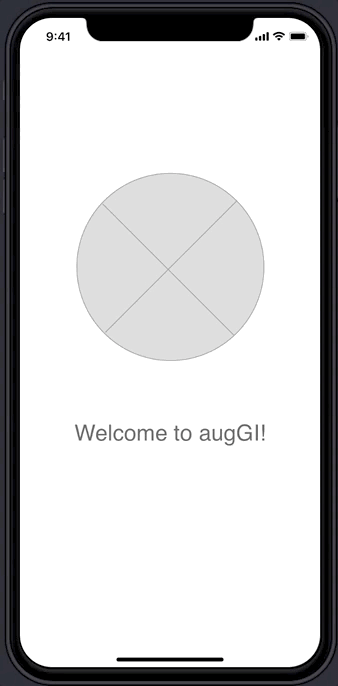
AUGGI An A.I. For Digestive Health Application
Client
Auggi
Dec. 2019 — Nov. 2018
Contributions
User Interface
Visual Design
Collaborators
MinzheJiang
Alfonso Martinez
David Hachuel
Cherry Gao
Danielle Capalino
Kyle Staller
Overview
Auggi helps patients with Irritable Bowel Syndrome (IBS) objectively track their lifestyle and symptoms in order to identify triggers and reduce flare-ups.
Chronic digestive disorders such as irritable bowel syndrome(IBS) affect a significant portion of the US population. About 20% of Americans suffer from IBS*. The purpose of this project is to help them get back control of their life.
* Sigrid Elsenbruch. 2011. Abdominal pain in Irritable Bowel Syndrome: A review of putative psychological, neural and neuro-immune mechanisms. Brain Behavior and Immunity 25, 3: 386–394. http://doi.org/10.1016/j.bbi.2010.11.0
Visual Identity
Auggi is a personal assistant that helps users keep track of their lifestyle and stool images. Users can start a conversation with Auggi by asking it questions and telling it how they feel. Users will gain confidence and certainty about their life with the help of Auggi and experts. It is a frictionless platform to manage chronic gut symptoms. My design approach for creating a visual identity for Auggi is a funnel process, which is filled with clear tasks and valuable outcomes for each step of the process. I start with visual positioning based on the information I know about competitors, industry, target audience, and the product tone of voice. Once we sync our vision as a team, I move forward by exploring shapes, colors, etc.






Bristol Chart
The Bristol Stool Form Scale(BSFS) is a clinically validated scale used extensively in clinical practice*. I made a custom version of the app to make it more aesthetically pleasing while preserving the core functionality for users.
*M. R. Blake, J. M. Raker, and K. Whelan. 2016. Validity and reliability of the Bristol Stool Form Scale in healthy adults and patients with diarrhea-predominant irritable bowel syndrome. Alimentary Pharmacology & Therapeutics 44, 7: 693–703. http://doi.org/10.1111/apt.13746


soft blobs with clear-cut edges, this form ideal. It is typical for a person who has stools twice or three times daily, after major meals.
Separate hard lumps, like nuts, then accumulates in the intestines for a long time, the moisture is absorbed excessively, often causes constipation or bloating.
sausage-like but lumpy, Poop long accumulates in the intestines, moisture is absorbed too much, often cause constipation or abdominal distension.
like a sausage but with cracks in the surface, It's normal, but it's already on the verge of water scarcity.
like a sausage or snake, smooth and soft, your mental state is also good, eating balanced to pull out such a good shape of the poop, congratulations!
watery, no solid pieces, often accompanied by sudden, water is almost completely not absorbed by the gut, too much pressure or overeating.
fluffy pieces with ragged edges, a mushy stool, close to diarrhea status, long-term easy to cause intestinal problems, may evolve into allergic bowel syndrome, please pay more attention.
Porridge
Gravy
Grapes
Corn cob
Banana
Chicken nugget
Porridge
Illustration
I drew a collection of illustrations to help Auggi's user understand the product better. The goal with this set of illustrations was to make the users more comfortable with the sharp use case. This collection of illustrations is used on the website, mobile onboarding, and, campaigns.


Get to know your gut


To start a conversion about how you feel
Get your life together with the help of an expert
Research
During the product development stage, we started a hotline built using Twilio, for Telegram and Facebook Messenger. The more frequently users updated us, the more comprehensive the summary report was. Our future goal is to deliver a fully functional mobile application to better serve our users’ needs.

Advantages Weakness Competitors




Analysis
I did in-depth research about directly and indirectly related apps on the market, to help patients keep track of their data related to bowel movement. Here are some take-aways. Most of those apps did a really good job of designing an easy-to-navigate user interface and provided consistent information for users to keep track of their symptoms and lifestyle data. However, none of them work with a digital-first vision or run an insightful correlation analysis. The datasets are usually inputted manually and lack analysis. These apps address the issue superficially but lack actionable insights. There are also some companies dealing with this issue at a micro level, such as Viome and Seed, as well as a lot of concept design projects like Backtoyou and E. chromi. However, dealing with the issue on a micro-level is very costly and lacks consistency. You can have a sample exam at a lab once, but it is almost impossible for patients to do it on a daily basis.
Take GoPoop and Cara as examples; I found that both of them have easy-to-use and user-friendly logging interfaces. GoPoop has a calendar view about all the bowel movements, which is more like a diary logging style and has an overview of a specific log entry if a certain day is chosen. It includes the color, type, time stamp, and duration of that stool. However, the visual aesthetic is very close to the real images, which is not comfortable to look at and not fun to use. Cara does a great job of using a color-coded system and beautiful illustrations to visualize the data input. However, it lacks data analysis, and the correlation diagrams are poorly designed without enough support and documentation. We come to the conclusion that it is well-designed but lacks consideration about usability and effectiveness.

Wireframe
I designed two versions of wireframes, after the user testing demos. The following is the final version of the wireframes.











